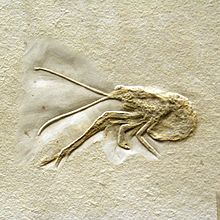
The Decapoda or decapods are an order of crustaceans within the class Malacostraca, and includes crabs, lobsters, crayfish, shrimp, and prawns. Most decapods are scavengers. The order is estimated to contain nearly 15,000 extant species in around 2,700 genera, with around 3,300 fossil species. Nearly half of these species are crabs, with the shrimp and Anomura including hermit crabs, king crabs, porcelain crabs, squat lobsters making up the bulk of the remainder. The earliest fossils of the group date to the Devonian.

Homarus is a genus of lobsters, which include the common and commercially significant species Homarus americanus and Homarus gammarus. The Cape lobster, which was formerly in this genus as H. capensis, was moved in 1995 to the new genus Homarinus.

The Achelata is an infra-order of the decapod crustaceans, holding the spiny lobsters, slipper lobsters and their fossil relatives.
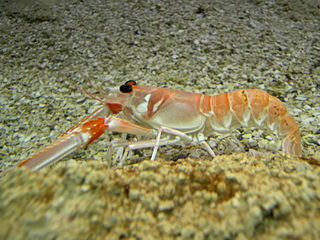
Nephrops norvegicus, known variously as the Norway lobster, Dublin Bay prawn, langoustine or scampi, is a slim, coral colored lobster that grows up to 25 cm (10 in) long, and is "the most important commercial crustacean in Europe". It is now the only extant species in the genus Nephrops, after several other species were moved to the closely related genus Metanephrops. It lives in the north-eastern Atlantic Ocean, and parts of the Mediterranean Sea, but is absent from the Baltic Sea and Black Sea. Adults emerge from their burrows at night to feed on worms and fish.

The Glypheoidea, is a group of lobster-like decapod crustaceans which forms an important part of fossil faunas, such as the Solnhofen limestone. These fossils included taxa such as Glyphea, and Mecochirus, mostly with elongated chelipeds. This group of decapods is a good example of a living fossil, or a lazarus taxon, since until their discovery in the 1970s, the group was considered to have become extinct in the Eocene. The superfamily Glypheoidea comprises five families. The two extant species, Neoglyphea inopinata and Laurentaeglyphea neocaledonica, are both in the family Glypheidae.
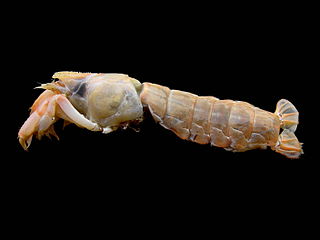
Thalassinidea is a former infraorder of decapod crustaceans that live in burrows in muddy bottoms of the world's oceans. In Australian English, the littoral thalassinidean Trypaea australiensis is referred to as the yabby, frequently used as bait for estuarine fishing; elsewhere, however, they are poorly known, and as such have few vernacular names, "mud lobster" and "ghost shrimp" counting among them. The burrows made by thalassinideans are frequently preserved, and the fossil record of thalassinideans reaches back to the late Jurassic.
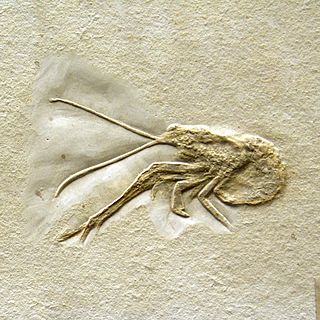
Glypheidea is an infraorder of lobster-like decapod crustaceans, comprising a number of fossil forms and the two extant (living) genera Neoglyphea and Laurentaeglyphea: The infraorder was thought to be extinct until a living species, Neoglyphea inopinata, was discovered in 1975. They are now considered "living fossils", with over 256 fossil species discovered, and just two extant species.

Metanephrops is a genus of lobsters, commonly known as scampi. Important species for fishery include Metanephrops australiensis and Metanephrops challengeri. It differs from other lobsters such as Homarus and Nephrops norvegicus in that its two main claws are of equal size, rather than being differentiated into a crusher and a pincher. There are 18 extant species recognised in the genus:

Hippoidea is a superfamily of decapod crustaceans known as mole crabs or sand crabs.

Albuneidae is a little-known family of specialized burrowing sand crabs. There are 50 extant species as well as nine fossil species that have been described. Fossil specimens have been described from the Cretaceous, Miocene and Oligocene.

Erymidae is a family of decapod crustaceans known only from fossils. They survived for 100 million years, from the Permo-Triassic boundary to the Albian. Eleven genera are recognised:

Eryonidae is a family of fossil decapod crustaceans which lived from the Upper Triassic to the Lower Cretaceous. It contains four genera: An aggregation of three unidentified eryonids was reported in 2012 inside a Late Jurassic ammonoid of the species Harpoceras falciferum; they represent the earliest evidence of gregarious behaviour in decapods.

Eocarcinus praecursor is a Jurassic species of decapod crustacean, sufficiently distinct from its relatives to be placed in its own family (Eocarcinidae). Often considered the oldest true crab, it was considered by a 2010 study to be an early member of the Anomura. However, a reanalysis in 2020 again found it to be the earliest known stem-group crab.

Palibacus praecursor is a fossil species of slipper lobster, the only species in the genus Palibacus. It was found in Cenomanian (Cretaceous) deposits at Hakel, Lebanon and described in 1886 by the German palaeontologist W. Dames. Its similarity to modern slipper lobsters demonstrates that the main features of that group had already evolved by the mid-Cretaceous.
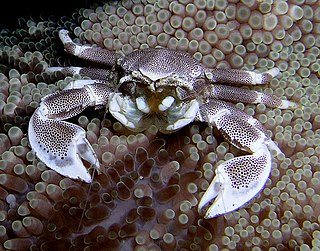
The Galatheoidea are a superfamily of decapod crustaceans comprising the porcelain crabs and some squat lobsters. Squat lobsters within the three families of the superfamily Chirostyloidea are not closely related to the squat lobsters within the Galatheoidea. The fossil record of the superfamily extends back to the Middle Jurassic genus Palaeomunidopsis.
Platykotta akaina is a species of decapod crustacean from the Triassic of the United Arab Emirates. It is the oldest known fossil from the infraorder Anomura, and is most closely related to Eocarcinus praecursor.

Cancrinos is a genus of fossil crustaceans closely allied with the slipper lobsters. One species is known, C. claviger from the Jurassic of southern Germany.
Tricarina is an extinct genus of crustaceans in order Isopoda, known from a single incomplete fossil specimen from the Cretaceous of western Iran. It has a flattened body with three longitudinal ridges, which give it its name.

Pseudastacus is an extinct genus of decapod crustaceans that lived during the Jurassic period in Europe, and possibly the Cretaceous period in Lebanon. Many species have been assigned to it, though the placement of some species remains uncertain and others have been reassigned to different genera. Fossils attributable to this genus were first described by Georg zu Münster in 1839 under the name Bolina pustulosa, but the generic name was changed in 1861 after Albert Oppel noted that it was preoccupied. The genus has been placed into different families by numerous authors, historically being assigned to Nephropidae or Protastacidae. Currently, it is believed to be a member of Stenochiridae.

Protastacus is an extinct genus of decapod crustaceans that lived in what is now Germany during the early Cretaceous period. The type species is P. politus, and a second species, P. antiquus, is also assigned to the genus. Protastacus grew to around 10 cm (3.9 in) long and had a mostly crayfish-like appearance, with enlarged pincer-bearing appendages and a segmented abdomen. Though formerly assigned to the Astacidae or Nephropoidea, it is currently placed as the only genus in the family Protastacidae, which in turn is the only family in the superfamily Protastacoidea.
